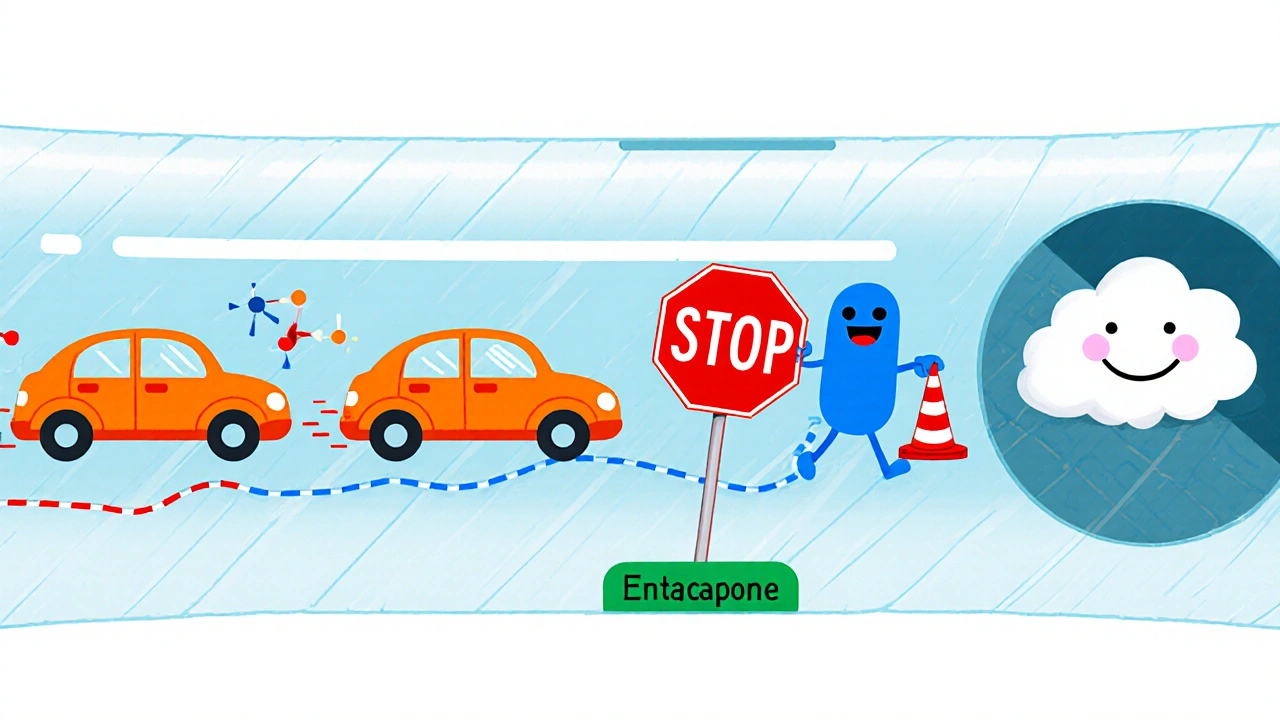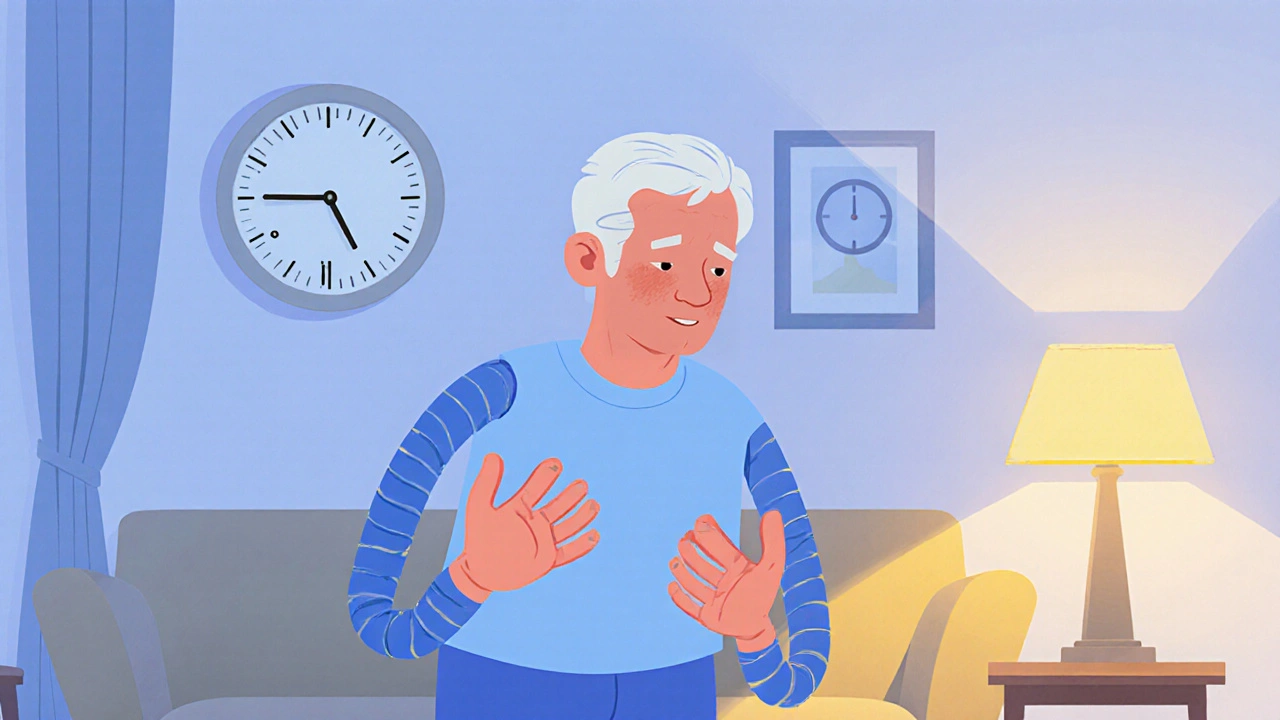Parkinson's Off-Time Reduction Calculator
Calculate Your Estimated Off-Time Reduction
This calculator uses clinical study data to estimate how much your daily 'off' time might decrease when taking carbidopa-levodopa-entacapone (Stalevo).
Note: Based on clinical studies, this medication typically reduces 'off' time by 1.5 hours per day on average, with a range of 1-2 hours. Actual results may vary.
Estimated Results
With carbidopa-levodopa-entacapone, your daily 'off' time may decrease by:
This represents a reduction from your current schedule
Your estimated new daily 'off' time would be:
People with Parkinson's disease often notice that their medication wears off before the next dose, leaving them with shaky hands, stiff muscles, or difficulty walking. This “off” period can be frightening and disrupt daily life. The three‑drug combination known as carbidopa-levodopa-entacapone was designed to smooth out those gaps. Below, we break down what the combo does, why “off” time happens, and how doctors use it to keep symptoms under control.
What is Carbidopa‑Levodopa‑Entacapone?
Carbidopa‑Levodopa‑Entacapone is a single‑pill formulation that merges three agents: levodopa, carbidopa, and entacapone. Levodopa is the direct precursor of dopamine, the brain chemical that dwindles in Parkinson's disease. Carbidopa blocks peripheral conversion of levodopa to dopamine, allowing more of the drug to reach the brain. Entacapone is a catechol‑O‑methyltransferase (COMT) inhibitor that slows the breakdown of levodopa once it’s inside the bloodstream, extending its effect. First approved by the FDA in 2004 under the brand name Stalevo, the triple combo is now a staple for many patients who experience motor fluctuations despite standard levodopa‑carbidopa therapy.
Why Do “Off” Periods Occur?
Parkinson's disease is characterized by a progressive loss of dopamine‑producing neurons in the substantia nigra. When patients take levodopa, the brain receives a surge of dopamine, improving movement. Over time, the brain’s ability to store and release that dopamine diminishes, so each dose produces a shorter burst of relief. The result is a cycle of “on” (good symptom control) and “off” (return of symptoms) periods.
Two key factors drive these fluctuations:
- Short plasma half‑life of levodopa: Levodopa is cleared from the bloodstream within 90 minutes, so its effect fades quickly.
- Peripheral metabolism: Enzymes like COMT and aromatic L‑amino‑acid decarboxylase (AADC) convert levodopa to inactive compounds before it can cross the blood‑brain barrier.
When the brain receives less dopamine, motor symptoms reappear, often unpredictably. This unpredictability is what patients refer to as “off” time.
How Adding Entacapone Helps
Entacapone works by inhibiting the COMT enzyme responsible for breaking down levodopa in the bloodstream. By slowing that breakdown, more levodopa stays available for the brain, lengthening the duration of each dose’s effect. In practice, adding entacapone can extend “on” time by 1-2hours per dose, cutting “off” periods by roughly 25‑30% for many patients.
Think of it like a traffic jam removal crew: the road (bloodstream) still has cars (levodopa), but without the crew (entacapone) they get stuck at a bottleneck (COMT). Remove the bottleneck, and the cars flow farther, reaching the destination (brain) more efficiently.
Clinical Evidence: Numbers That Matter
Multiple randomized controlled trials have examined the impact of the triple combo on motor fluctuations. A landmark 2005 study involving 509 patients showed a mean reduction of 1.5hours of “off” time per day compared with levodopa‑carbidopa alone. Another 2022 meta‑analysis of five trials (total n=2,134) reported:
- Average increase in “on” time without troublesome dyskinesia: 1.8hours.
- Mean decrease in total “off” time: 1.6hours.
- Improvement in UPDRS‑III motor scores by 4.2 points.
Importantly, the safety profile remained comparable. The most common side effects were nausea, diarrhea, and orange‑colored urine-both predictable effects of levodopa and entacapone.

Practical Dosing and Safety Tips
When switching a patient from levodopa‑carbidopa to the triple combo, clinicians typically start with a dose that matches the patient’s previous levodopa intake and then adjust based on response. Here’s a typical titration schedule:
- Initiate with one tablet containing 100mg levodopa, 25mg carbidopa, and 200mg entacapone.
- After 3‑5days, assess “on” time. If still <4hours, increase to 150mg levodopa/37.5mg carbidopa/300mg entacapone per tablet.
- Maximum recommended daily levodopa dose is 800mg; do not exceed 4tablets per dose.
Key safety considerations:
- Hepatic function: Entacapone is metabolized in the liver; baseline liver enzymes should be checked.
- Hemoglobin A1c: Some patients report mild elevations in blood glucose; monitor if diabetic.
- Interaction with MAO‑B inhibitors: Combining entacapone with rasagiline or selegiline can increase the risk of hypertensive crises; maintain a washout period of at least 24hours.
Carbidopa‑Levodopa‑Entacapone vs. Standard Levodopa‑Carbidopa
| Aspect | Levodopa‑Carbidopa | Carbidopa‑Levodopa‑Entacapone |
|---|---|---|
| Primary Mechanism | Increases brain dopamine by delivering levodopa; carbidopa blocks peripheral AADC. | Same as dual therapy plus COMT inhibition to prolong levodopa plasma half‑life. |
| Typical “On” Time Gain | Baseline. | +1.5‑2.0hours per dose. |
| Common Side Effects | Nausea, orthostatic hypotension. | All dual‑therapy side effects + orange urine, mild liver enzyme rise. |
| Convenience | May require multiple doses per day. | Fewer daily pills for comparable levodopa exposure. |
For many patients, the extra hour or two of smooth motor control outweighs the modest increase in gastrointestinal discomfort. The decision ultimately rests on individual tolerability and lifestyle needs.
Patient Stories: Real‑World Impact
John is a 68‑year‑old retired teacher diagnosed with Parkinson’s 6years ago. He reported “off” episodes lasting up to 3hours each afternoon, forcing him to cancel his weekly bridge club. After switching to the triple combo, his “off” time dropped to under 30minutes, and he could attend meetings without interruption. Similar anecdotes appear in the Parkinson’s Foundation’s patient registry, underscoring the practical benefit beyond clinical trial numbers.

When the Triple Combo Might Not Be Right
Despite its advantages, the combo isn’t universally suitable. Consider the following scenarios:
- Severe liver disease: Entacapone clearance is compromised.
- History of neuroleptic‑induced psychosis: Higher dopamine levels can exacerbate hallucinations.
- Concurrent use of non‑selective MAO inhibitors: Risk of hypertensive crisis.
In such cases, clinicians may opt for a levodopa‑carbidopa regimen plus a separate COMT or MAO‑B inhibitor, tailoring therapy to the patient’s comorbidities.
Quick Reference Checklist for Clinicians
- Confirm diagnosis of Parkinson’s disease and document baseline “off” time.
- Assess liver function (ALT, AST) before initiation.
- Start with the lowest effective tablet; titrate every 3‑5days.
- Monitor for orange urine and gastrointestinal upset; counsel patients that it’s harmless.
- Re‑evaluate motor fluctuations after 2weeks; adjust dosing or consider adjunctive therapies if needed.
Frequently Asked Questions
Frequently Asked Questions
What is the main benefit of adding entacapone?
Entacapone blocks the COMT enzyme, extending levodopa’s presence in the blood and therefore lengthening the “on” period by about 1‑2hours per dose.
Can I take the triple combo with my current MAO‑B inhibitor?
Most guidelines advise a 24‑hour washout between a non‑selective MAO inhibitor and entacapone. If you’re on a selective MAO‑B inhibitor like rasagiline, discuss the risk of hypertension with your neurologist.
Why does my urine turn orange?
Entacapone is metabolized into a colored compound that colors urine orange. It’s harmless and disappears after stopping the drug.
Is the triple combo safe for older adults?
Clinical trials show a similar safety profile across age groups, but seniors should be monitored for dizziness and possible liver enzyme changes.
How quickly will I notice a reduction in “off” time?
Most patients report improvement within 1‑2weeks of dose stabilization, though exact timing varies with disease stage and individual metabolism.
In sum, carbidopa‑levodopa‑entacapone offers a practical way to stretch the therapeutic window of levodopa, giving patients smoother movement and more control over their day. As always, any medication change should be made under the guidance of a neurologist familiar with the patient’s full medical picture.

lee charlie
October 16, 2025 AT 13:13Reading about the combo feels hopeful
It’s good to see science tackling those off periods
Patients often feel isolated when meds wear off
Knowing there’s a pill that can smooth out spikes is reassuring
Stay strong and keep working with your doctor
Greg DiMedio
October 26, 2025 AT 09:43Wow another fancy pill, because the first one wasn’t confusing enough. Guess we’ll just add another name to the stack.
Badal Patel
November 5, 2025 AT 07:13Esteemed colleagues, the pharmacological rationale behind the inclusion of a catechol‑O‑methyltransferase inhibitor is most compelling; indeed, the prolongation of levodopa bioavailability constitutes a paramount advancement. Yet, one must ponder whether the incremental increase in "on" time truly outweighs the metabolic burden imposed upon hepatic pathways. The study referenced, whilst statistically robust, lacks granularity in patient‑reported outcomes… Consequently, clinicians should calibrate dosage with meticulous care; otherwise, dyskinesia may ensue nevertheless! The interplay of peripheral and central metabolism remains a complex tapestry, demanding further elucidation. Was the sample size sufficient? arguably not-the heterogeneity of disease progression was under‑addressed. Nevertheless, the therapeutic potential cannot be dismissed. In sum, a cautious yet optimistic integration into practice is advisable
KIRAN nadarla
November 15, 2025 AT 04:43I must point out a glaring error in the usage of the term “off” time-it should be hyphenated when used adjectivally as “off‑time”. Moreover, the article omits the crucial distinction between motor fluctuations and dyskinesia, which could mislead readers. The inclusion of orange‑colored urine as a side effect, while accurate, is presented without proper citation; a reputable source is mandatory. Additionally, the dosing schedule lacks a discussion of titration nuances such as bedtime dosing considerations. While the content is generally sound, the style oscillates between colloquial and academic, creating a jarring reading experience. Please ensure future submissions adhere to both grammatical precision and consistent tone.
Kara Guilbert
November 25, 2025 AT 02:13Its irrsponsible to ignore the suffering of patients by prescribing cheap meds without considering their quality of life. We must hold the pharm industry accountable for pushing complex combos that may burden patients financially.
Sonia Michelle
December 4, 2025 AT 23:43When we think about medication beyond its chemical composition, we enter a dialogue about autonomy and dignity. The ability to reduce off periods empowers individuals to reclaim daily routines that define their humanity. This synergy of science and personal agency reflects a deeper ethical commitment to patient‑centered care. Let us support one another in navigating these therapeutic options with informed confidence.
Neil Collette
December 14, 2025 AT 21:13Oh, you think adding a COMT inhibitor is just “more pills”? In reality, the enzymatic inhibition reshapes pharmacokinetics, which most laypeople overlook. So before you dismiss it as a gimmick, remember that the brain's dopamine reservoir is a fickle beast.
James Lee
December 24, 2025 AT 18:43Another “breakthrough” that’s just more hype than real change.